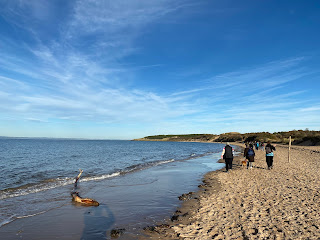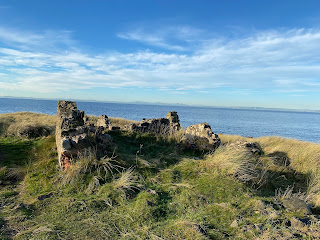Last week I was in Edinburgh for work, and I had the opportunity to get out of that lovely city for a walk along the coast to the east with some colleagues. With its dunes and picturesque seascapes, the East Lothian coast is a truly beautiful part of Britain (even the golf courses look nice, and I say that as someone who agrees with Winston Churchill (or was it Mark Twain?) in that I consider that sport to be “a good walk spoilt”). There are some first-class birding locations on the East Lothian coast such as Aberlady (the country’s first-ever designated Local Nature Reserve) and the boat trips out to Bass Rock from North Berwick, which is home to the Scottish Seabird Centre.
Both of those experiences are ones to look forward to another time, though. Last week, it was a lovely walk along the beach by Gullane.
Weather-wise, it was a near-perfect day for it, with clear blue skies and not much wind. There were plenty of waders to be seen, principally Oystercatchers, those distinctive black-and-white ones with the long orange-red bulls. Looking at a group of them on an offshore rock with the binoculars, I could see that they were accompanied by some Turnstones and a lone Curlew.
Along the path was the ruin of an old stone hut. What must this have been? Have any hikers made use of it as a shelter on windy days or perhaps nights?
Later on, I saw more waders in the form of a dozen or so Knots and a couple of Bar-tailed Godwits. There were plenty of Cormorants flying low over the sea, and a couple of Shelducks seen from a distance. A couple of groups of geese flew overhead in V-formation but they were too quick for me to make an identification; regular Greylags, or something more?
Gull-wise, I saw those of the Herring and Black-headed varieties, while the beach was also popular with Carrion Crows. A little brown bird was too quick for me; Meadow Pipit, most likely.
Back in Edinburgh, I had the chance — always taken if offered — to climb Calton Hill for wonderful views over the city and the Firth of Forth; assorted pigeons, gulls and crows were seen up there. Sure, Arthur’s Seat is better known — but there just wasn’t enough time. As with Aberlady and Bass Rock, one for another time when this part of the world, and its birding potential, can be explored further.






No comments:
Post a Comment